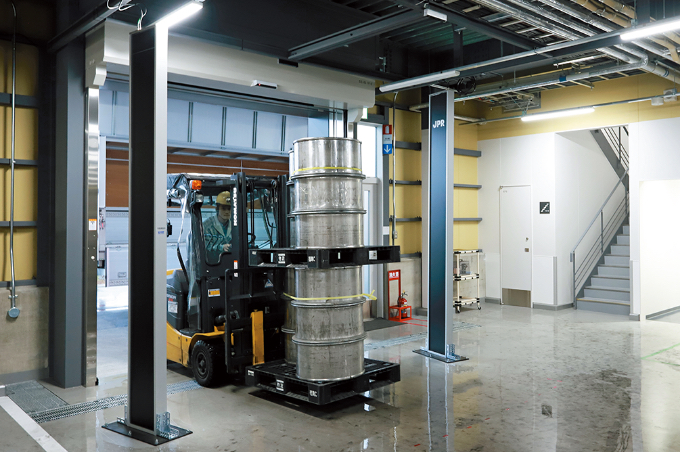FUKUSHIMA CANON INC.
Introduced RFID for inventory management, business automation and to improve space efficiency
*The information at the time of publication in February 2019 posted as it is.
*The company names and product names mentioned are registered trademarks or trademarks of the respective companies.
RFID (Automatic Identification Technology), which uses wireless waves to read and write data in IC chips in a contactless manner, has been attracting attention as a tool to realize advanced management and operational efficiency.
The "100 billion electronic tags for convenience store" formulated by the Ministry of Economy, Trade and Industry is just one example.
We interviewed Mr. Hiroki Kato of FUKUSHIMA CANON INC., who decided to utilize RFID for efficient inventory management for printer ink chemical products.

Mr. Hiroki Kato, System Engineering Department, FUKUSHIMA CANON INC.
An operation system utilizing advanced technology
FUKUSHIMA CANON INC. is the core production base for inkjet printers in the Canon Group and operates an automated line for ink production to cartridge packaging 24 hours a day. As the mother factory of the inkjet business, they also supply ink to other factories.
The System Engineering Department, which is responsible for the development and operation of the company's core systems, started to cooperate with the Production Management Department to construct a system to achieve more efficient product management by utilizing RFID.
The company proactively utilizes advanced technologies to help improve its operations. This RFID inventory management system is made in-house, and its technology and operational know-how will be applied to other group companies.
Turning point for RFID utilization
The target of the newly developed operation system is for inventory management of drums used for transportation and storage of the manufactured ink. Up until now, barcodes were used for management, however many issues such as cleaning time management, aging management, location management, and many other were unsolved. Therefore, they started to conduct research in 2016 to automate work by utilizing RFID technology.
Even after investigating and testing many RFID tags, antennas, gates, and handy-type readers, we couldn’t find the path for the developing the right system. "So we consulted with the Distribution System Development Center, which is a member of GS1, an international organization on distribution code management and distribution standards, who introduced us to JPR," Mr. Kato recalls. JPR is the first in the industry to provide an RFID system that complies with the international standard code system EPC global. "At the JPR depot, we asked about the standardization activities for RFID and EPCIS, and finally we could see the path to the realization of RFID inventory management," says Mr. Kato. After verifying the specifications and performance of the "epal gate" at the depot, we looked into the future as a member of a global company and adopted the product that complies with the international standard EPC.
High reading accuracy and range
They proceeded with operation system development in line with the construction of the new building and started operating the new system in January 2018. The "epal gate" was installed at the entrance of the storage and automatically reads the individual information from the tag attached to the drum containing the ink. The placement of tag was moved to a place where it was easy to read without disturbing cleaning and transportation. The read EPC data is linked to information such as lot numbers, part numbers, and manufacturing numbers, and is used for inventory and quality control.
"Compared to other RFID gate products, the "epal gate" has very few misreads," says Mr. Kato. It is also attractive that it is easy to tune the antenna and adjust the reading range and output. "Being able to read with a pinpoint accuracy is a big advantage. If it reads the surrounding, we will be restricted with the place and organizing the flow line. If that happens, work efficiency and space efficiency will deteriorate," Mr. Kato said.
The gate is not limited to the physical size, but the reading range becomes the exclusive range. "As a characteristic of radio waves, RFID inevitably radiates into the back surface and wraps around it, but even when the drum was temporarily placed on the back surface of the gate, there was almost no inaccurate reading. However, this was just tested in that situation. Therefore, it is necessary to verify according to the situation when widely deploying this system," says Mr. Kato. For RFID, it is important to understand and control the combination of the antenna, the tag, and the reader that controls it, as well as the characteristics of the antenna.
Normally, two drums containing ink are stacked flat on one pallet, and two drums are stacked for empty drums. Since the height is 2.50m in the case of two-tier stacking, there was a problem in difficulty reading with a general patch antenna, but the "epal gate" can cover a reading range of 3 m.
Horizontal development of RFID
Upon installation, adjustments were made while verifying the distance and signal level based on the JPR depot test results. Mr. Kato says he was particular about the angle of installation. "The gates are installed in an inverted V shape. By pointing the antenna outside, the readings are concentrated at the entrance and exit, and the radio waves do not reach anywhere else.
"While we have challenged ourselves to develop RFID and deployed the system on drums, in the future we would like to build a management system that includes other bases," says Mr. Kato.
He concludes, "Thank you for providing us with information, which led to the adoption. We would like you to continue to take onboard the global movement of RFID and develop products and services that contribute to the efficiency of logistics. Easy to use, effective, and we are looking for something that can be used in various places," Mr. Kato told us about his request for JPR.
What is "epal gate"?
Epal gate is a gate-type reader system suitable for reading UHF RFID tags attached to physical distribution containers transported by forklift (FL). With general patch antennas, (1) the reflection of radio waves when passing through the FL and (2) the dead angle of the radio wave due to substances such as metal and water have been problems for many years, but this has been addressed by combining many linear polarization antennas with a short reading distance. In doing so, it achieves a reading area with fewer blind spots that suppress reflection when passing through the FL.
JPR will combine this gate with services such as RTI's total management system "epal" and logistics container individual management system "Logiarx" to propose more convenient logistics standardization and efficiency.

*RFID (Radio Frequency IDentification) is an epoch-making information technology that uses the Internet to enable people and things to be identified and managed with a small wireless chip. IC cards such as Suica and Edy (contactless payment cards) are examples of high-profile RFID applications.

